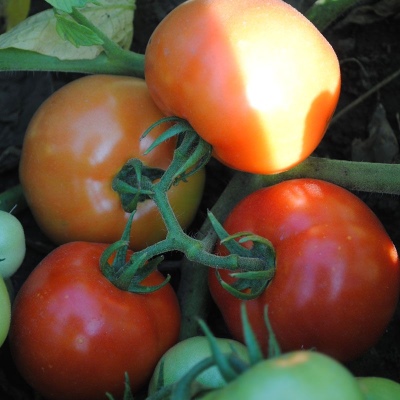
- Authors: Frits Herlaar (Enza Zaden)
- Year of approval: 2011
- Name synonyms: Lojain
- Category: hybrid
- Growth type: determinant
- Appointment: fresh consumption
- Ripening period: mid-season
- Growing conditions: for open ground
- Marketability: high
- Transportability: Yes
Experienced gardeners and farmers always try to choose tomatoes with bountiful yields and simple agricultural techniques for growing, which grow in any bad weather. These include a hybrid type of tomato with the unusual name Lodge.
Breeding history
The Lodgein hybrid tomato variety is a breeding creation of Dutch scientists. The nightshade crop was bred for a long time (back in 1938) by the agricultural holding Enza Zaden (Holland), but it was allowed for use only in 2011. In the same year, the plant was included in the State Register of the Russian Federation for the Central Black Earth Region. Over the years, the variety has improved, making it ideal for growing in the hottest and driest regions of Russia.
Description of the variety
The Logjane tomato is a determinant low-growing plant, up to 80 cm high. Tomato bushes are endowed with a strong thickening of dark green foliage, strong stems and branches, a developed root system that feeds the plant with vitality, as well as a simple type of inflorescence. Each fruit cluster is 5-6 ovaries (berries).
During cultivation, the bushes require the formation of 1-2 stems, an obligatory garter, since the branches and the stem do not always withstand the weight of weighty tomatoes, the removal of unnecessary stepsons.
The main qualities of the fruit
Logane Tomatoes represent a class of medium-fruit vegetables. On average, the berry gains weight up to 94-110 grams. The shape of the berry is classic - rounded with slightly pronounced irregularities. In a state of full ripeness, the fruits are uniformly colored red, in an immature state they have a green color. The peel of the berries is quite dense, glossy with a perfectly smooth surface. It is the dense peel that protects the tomatoes from cracking, and also makes them transportable and preserves marketable qualities for a long time.
Tomato belongs to the category of salad, so it is consumed fresh, cut into salads, and also processed into ketchup and juices. Experts do not recommend preserving at home.
Taste characteristics
Given the hybridity of the species, the taste of vegetables is excellent. Their flesh is dense, fleshy, very juicy, without seeds and white veins. The taste is sweet, without a hint of sourness or bitterness, complemented by a light spicy aroma.
Ripening and fruiting
The Dutch tomato is mid-season. From the moment of the first shoots to ripe berries on the branches, only 3 months pass (75-95 days). The fruiting period is somewhat extended, which allows you to enjoy delicious tomatoes for a long time. The berries are gradually ripened. The active phase of productivity falls on July-August.
Yield
Tomatoes are characterized by high yields. Observing all the rules for caring for the crop, you can get an excellent harvest. If we evaluate the indicator on an industrial scale, then from 1 hectare is collected from 201 to 361 centners of fruits. If collected from a garden bed, then 1 bush per season gives up to 3.5 kg of berries.
The timing of planting seedlings and planting in the ground
Sowing seeds for seedlings is carried out in late March - early April. The first shoots appear 7-10 days after sowing. It is necessary to grow bushes with good lighting and a room temperature of + 15 ... 18 degrees. At the stage of appearance of 3 leaves, the seedlings are seated in separate cups (dive).
Before planting in a permanent place, you can harden the plants, which makes it easier for the bushes to get used to the new growing environment. Landing in the greenhouse is carried out at the end of May, and in the open ground - in the beginning of June.

Growing tomato seedlings is an extremely important process, because it largely depends on whether the gardener will be able to harvest at all. All aspects must be taken into account, from seedbed preparation to planting in the ground.
Landing scheme
It is recommended to take into account the planting density and the scheme when planting bushes in the garden or greenhouse garden. Up to 3-4 bushes can be placed on 1 m2. Correctly for landing, it is considered to be a 40x60 cm scheme.

Growing and care
Tomatoes should be grown in loose, breathable and fertile soil, free of weeds. The best would be a site where previously grown vegetables such as onions, cabbage, beets or carrots.
A special culture does not require care, but standard measures need to be carried out: watering, fertilizing, loosening the soil, forming and tying a bush, removing unnecessary stepsons, ventilating (if it is a greenhouse) and preventing diseases.




A plant needs different micronutrients at each stage of growth. All fertilizers can be divided into two groups: mineral and organic. Folk remedies are often used: iodine, yeast, bird droppings, eggshells.
It is important to observe the rate and period of feeding. This also applies to folk remedies and organic fertilizers.
Disease and pest resistance
The variety has a high resistance to many tomato diseases - verticillium, tobacco mosaic virus, fusarium wilting, apical rot. It is extremely rare that the plant is affected by yellow curl. The variety attracts more pests, especially aphids, whiteflies, spider mites. Treatment with special preparations - insecticides - will help protect the crop from pests.
Resistant to adverse conditions
The resistance to stress in vegetable crops is at a high level. She is not afraid of temperature drops, prolonged droughts and sultry heat. Due to the dense foliage, the fruits are not baked in the scorching sun. The only thing that the plant does not withstand is drafts and gusty winds.



























































































